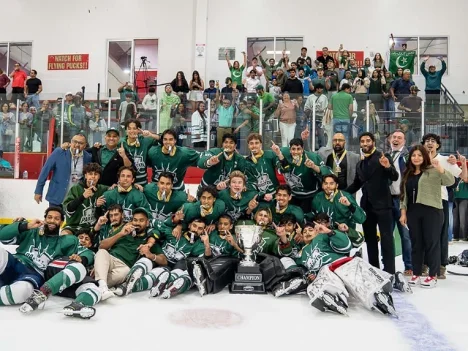The rink in Coral Springs on August 21, 2025, felt like the stage of a film’s final act. The clock bled toward zero, but the arena itself seemed to hold its breath. Green 6, Peru 1, the score burned on the board, but nobody dared exhale until the whistle. The puck clattered against the boards, its echo carrying through the ice like a drumbeat of destiny. Fans’ breath hung in the cold air, trembling wisps above lips that whispered the countdown: three, two, one… The horn blared.
Silence shattered into thunder. Jerseys flew into the air. Sticks fell like spears onto the ice. Green flags unfurled in the stands, trembling in fists that could no longer hold back tears. For the first time, Green men’s national team was champions of the Amerigol LATAM Cup, Division III, undefeated and undeniable. Players hurled themselves over the boards in a storm of joy, collapsing into one another. “An amazing day for the country and ice hockey,” declared head coach Kameron Sabir, his voice cracking in the chaos. It was more than a victory; it was a declaration.
The Puck’s Journey and Pakistan’s Identity
If the puck itself could speak, it would tell you how history was carved into its spinning body. Dropped onto the ice at the first face-off, it had belonged briefly to Peru’s blades, but soon, Pakistan’s speed claimed it. Across the neutral zone it raced, whipped in cycles by Jordyn Mughal and Trystan Mughal, who combined size and touch to lock Peru in their end. It felt the sting of Mahd Nasir’s left-shot release, the north–south surges of Tariq Khan and Zaakir Khan, who sprinted like lightning under compressed tournament schedules.
It moved with the stride of Bilal Balti and Kole Ahmad, defenders who turned defense into mobility. And when Peru struck back, the puck slammed harmlessly into the pads of Colton Khan and Braeden Shaikh, guardians of the crease. By the time it was whipped into the net for the sixth time, the puck had become witness to destiny.
From Debut Struggles to a Flawless Campaign
Up in the stands, a fan lived another story. A year earlier, Green Team had scraped just one win on debut. Now, that same fan screamed through tears, watching their side complete an undefeated 5–0 campaign. And this wasn’t just any tournament. The 2025 LATAM Cup, backed by the NHL and Florida Panthers, had drawn 62 teams and more than 1,450 players from 17 countries and territories. It was the crucible where new programs tested their structure and soul. To rise to the top in only their second year was staggering. As Dawn, NHL, and others reported, this was no miracle fluke.
It was, in truth, a “flawless campaign.” The final was Pakistan’s identity written in ice. Transition speed. Direct off the rush. Discipline without the puck. Peru, making waves in its own first LATAM Cup, fought with courage, but the second period belonged entirely to Pakistan. Their layered forecheck suffocated Peru’s rhythm. Outlets confirmed the 6–1 margin; Gulf News and The Express Tribune underlined the perfect record. This wasn’t luck. This was authority.
Beyond the Trophy: A Prologue for Green Team Hockey
Behind the surge was Sabir’s simplicity: short shifts, clean exits, energy conserved, the middle of the ice protected. No overcomplication. Just clarity. And it showed late in games, when Pakistan still had legs while others faded. Even belief was managed. Donny Khan, NHL development executive, admitted: “We’d bewinning several years from now.” Instead, Pakistan proved the future had arrived early.
That makes the victory bigger than a single trophy. Pakistan has almost no domestic ice, limited IIHF-standard rinks, and a national pathway still in its infancy. The LATAM Cup exists precisely for this: to give countries the chance to prove themselves, to justify investment.
Across Pakistan, the media hailed the symbolism. But beyond symbolism lay leverage: proof that with structure, results follow. So, when the horn sounded, it wasn’t just a win. It was the moment underdogs became legends. The men lifted gold; the women, on debut, claimed bronze in Division II. Two medals on one day, one declaration written across the rink: Pakistan had arrived. A flawless run.
A forged identity. A core group of young and teachable individuals, with an average age under 20. The flags still rose, the breath still hung, the horn still echoed. Under the floodlights of Coral Springs, Pakistan’s men didn’t just win a championship. They opened a prologue, the story of how hockey in green found its place in history.
Also Read: Kulsoom Hazara: The Unstoppable Phoenix of Quetta


